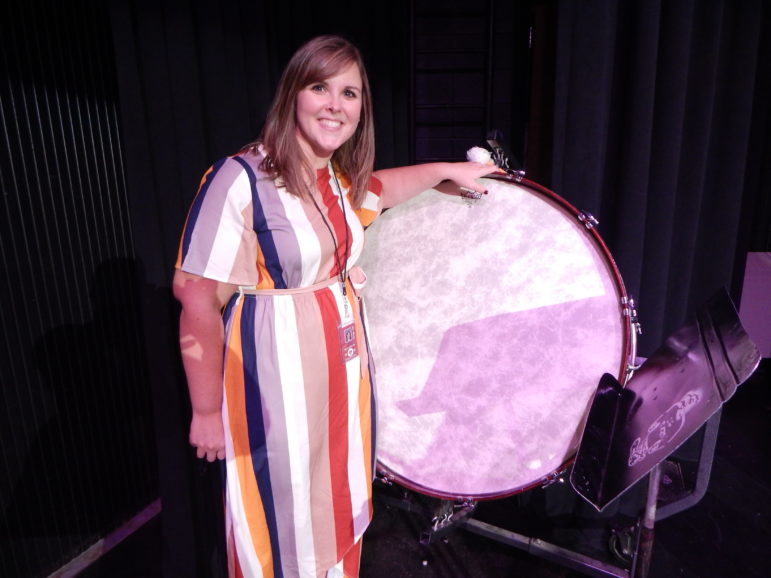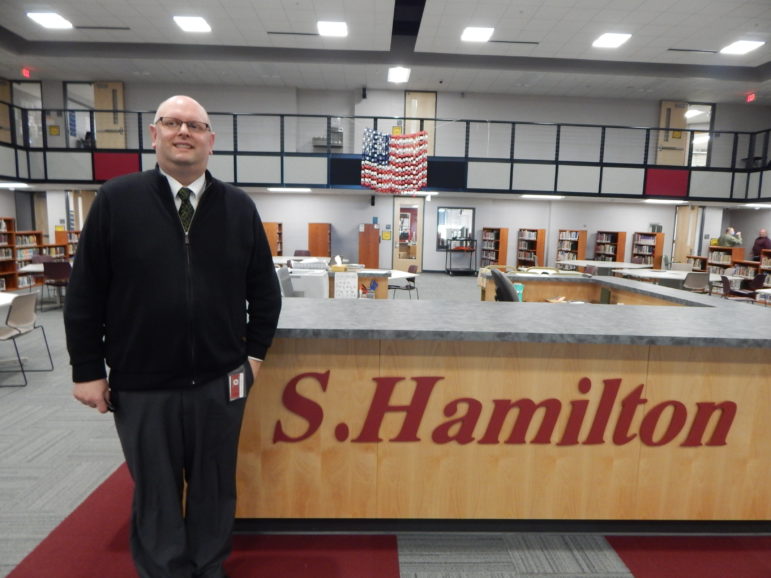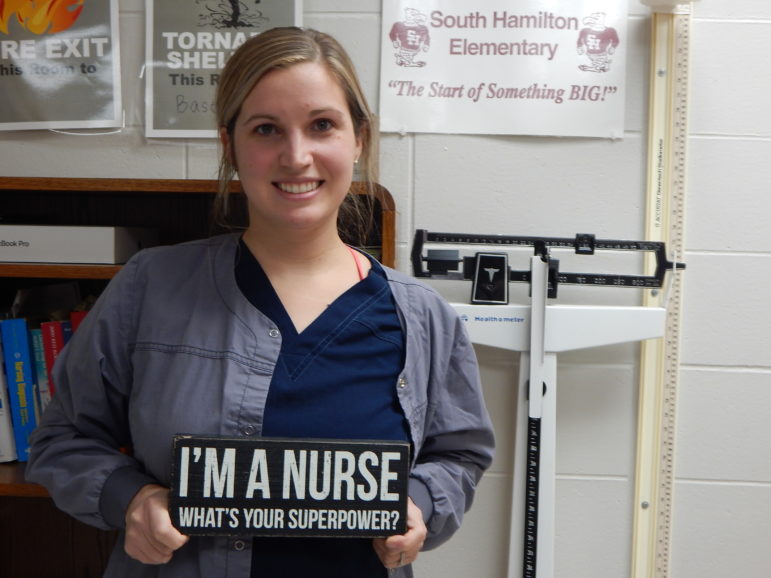Confronting the What-Ifs of Learning (and Teaching) During COVID: Meet the Iowa Educators Helping One Rural School District Endure the Pandemic

This piece, originally published by IowaWatch, is part of a collaborative pandemic reporting project led by the Institute for Nonprofit News and member newsrooms. (See more rural case studies at The 74)
Gusty winds blew corn husks through the school’s parking lot on November 16 at South Hamilton Schools
It was another day of the staff trying to keep up with the daily reports of sickened students and faculty, making sure kids pumped hand sanitizer and wore face masks nearly all the time, properly social distanced during band practice and lunch periods, and pivoted from teaching in-person and virtual learners while taking extra time to help those struggling.
Even the lunchroom is different this year.
Cafeteria tables limit seating.
Extra tables have been set up in a balcony area of the high school gym; the scent of pasta with marinara and alfredo sauce lingers near the school banners declaring South Hamilton’s athletic prowess.
Here are more glimpses of the South Hamilton school district of more than 700 students and the community.
The Superintendent
Ken Howard’s office shows off the history of South Hamilton like a freshly opened time capsule.
There are historic momentos on the wall, from a 1968 program from the opening of the current buildings in Jewell to the lyrics of the school song.
There are also current reminders of this year, like the mask that rarely leaves his face.
No one could have anticipated the radical changes to the way Iowa instructs its students. According to the Iowa Department of Education, there are 330 public school districts, 487,652 students and 37,386 teachers. They work in 1,316 buildings.
In mid-March, Howard saw the rapid spread of COVID-19 across Iowa and the United States.
“I saw this and said, ‘Oh, this is hitting our own doorstep,’ “ Howard said.
Howard helped gather resources and the community pitched in to keep kids on the path to learning.
Local telephone companies set up WiFi connections to keep kids online for remote learning. Staff members spent hours of extra time to prepare lesson plans and develop innovative ways of teaching. Local churches opened their doors to give students socially distanced space for working on their laptops during spring, summer and fall.
The school district’s towns set up food distribution sites for families who were hit financially. Hamilton County’s unemployment rate flared up to 9.2 percent in April but has been sliding since then, U.S. Department of Labor Statistics data show.
A food pantry at Bethesda Lutheran Church in Jewell helps feed the hungry, said Leo Reiter, the town’s mayor.
“Our local food bank has drive-by pickup; they take stuff out to people,” Reiter said.

The Band Leader
A plastic tub in the South Hamilton band room reads “USED.” Aside it is a basket that says “CLEAN.”
Inside each container are drumsticks, some of which are sanitized.
It’s another simple way to help protect students from catching the virus.
Band instructor Alexa Gibbs is serious about cleanliness. There are 140 band students for grades 7-12.
The school’s auditorium is marked with assigned seats six feet apart for students, spread out over socially distanced areas.
For brass players’ proficient spit valves, puppy housetraining pads are on the floor to soak up the deluge.
“It’s more beneficial to have something rather than nothing,” Gibbs said.

The Principals
Steve Neuberger, who oversees the elementary school, and Jason Woodley, who runs grades 7-12, started their positions in July.
They faced redesigning the schools to make them safe while keeping students motivated and on the path to graduation.
Woodley walked into the school lunchroom, where students have a diet of not only meals, but socialization. He eyed it with a new perspective, using a Disneyland perspective — a fun experience driven by enthusiastic employees, even if masks are required.
“Let’s pretend this is the greatest place on earth, in the cafeteria,” he said.
Academic plans had to be drawn up for a variety of situations: Online only learners, in-person students and a hybrid schedule that was used during the mid-September outbreak.
“I feel like everyone’s bought in,” Neuberger said. “This is something we’re going to have to do.”
It’s a continual effort.
“Nobody could really wrap their heads around it; it’s almost like people have embraced the craziness of the year,” Neuberger said. “In the end, we’re going to embrace that it’s the best that we can do for our kids.”

The School Nurse
Shelby Fonken serves on the front line between the South Hamilton school doors and COVID-19.
Children with a fever, cough or runny nose wander into her office.
She plays a critical role in keeping students and staff safe, while working with the public to keep fear from enveloping the community. Fonken does contact tracing of students who have tested positive for the virus, tracking down a student’s known whereabouts for 48 hours before he or she first felt sick at school.
One critical part of her job is providing information about COVID-19 on the school website. South Hamilton posts daily notices of how many children and staff members are missing school.
It’s a bold step to provide those details, because some school districts don’t share them.
“To me, there’s no secrets with COVID,” Woodley said.
In her first months since she started in August, she’s become an essential part of the South Hamilton team.
“We’re all in this together,” Fonken said. “We’ll get through it one day at a time.”

The Teacher
Elementary physical education teacher Jeff Steines’ created his own YouTube.com channel (SHCoachSteines) to keep kids active.
From March until June, he created a “Be Like Mike Challenge,” asking students to perform and record their own basketball feats. Being inspired by NBA great Michael Jordan was an obvious choice, as posters and photos of Jordan decorate Steines’ desk and office walls.
Two students using leaf blowers to keep a ball suspended in midair? Done.
Putting value on hitting targets? Got it.
“I just want them moving,” Steines said.
South Hamilton has utilized technology to help reach kids during the pandemic. Area communities have had improved broadband access this fall, thanks to local providers who have increased signal strength for some laptops.
If it’s a problem reaching students who aren’t in the building, then Steines will find a way.
“If there’s a barrier, we’ve got to knock that down,” Steines said.
This piece, originally published by IowaWatch, is part of a collaborative reporting project called “Lesson Plans: Rural schools grapple with COVID-19”. It includes the Institute for Nonprofit News, Charlottesville Tomorrow, El Paso Matters, Iowa Watch, The Nevada Independent, New Mexico in Depth, Underscore News/Pamplin Media Group and Wisconsin Watch/The Badger Project. The collaboration was made possible by a grant from the Walton Family Foundation, which also funds The 74.
Get stories like these delivered straight to your inbox. Sign up for The 74 Newsletter

;)